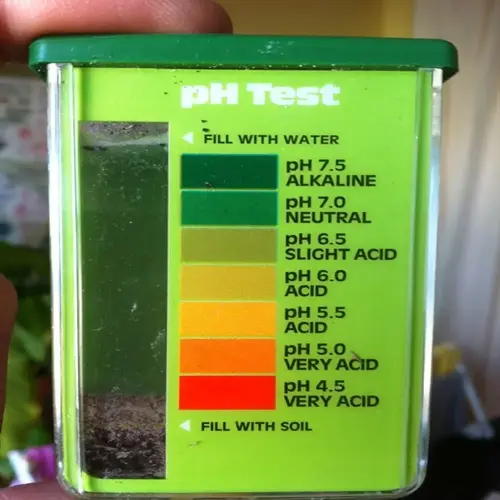Ultimate Spider Mite Control Guide

Written by
Liu Xiaohui
Reviewed by
Prof. Martin Thorne, Ph.D.It is crucial to maintain humidity levels ranging from 60-80% for controlling spider mites effectively.
For pest infestations that require immediate action, release the spider mite predator Phytoseiulus persimilis at a release rate of 1 predator for every 10 spider mites.
Only apply neem oil at night if possible, at a dilution of 2 tablespoons per gallon of water.
Always isolate new plants for 14 days to prevent the introduction of mites.
In order to recognize damage from spider mites, you can identify the early damage by looking for yellow stippling under the leaves when using 10x magnification.
Dispose of heavily infested plants only after 21 days of treatment failure.
Article Navigation
Effective spider mite control starts by knowing your enemy. These tiny pests, measuring less than 1mm in size, cause significant damage to plants worldwide. By piercing plant cells and sucking out the nutrients, they render the telltale stippling of the leaves on the plants. Hot, dry conditions will allow them to breed every 5 days.
I have witnessed entire crops of tomatoes destroyed by pest infestations within weeks. The silken web is an ominous sign of vigorous attacks. Potato growers are reporting the loss of up to 8 tons per hectare. Prevention is better than cure with these rapid breeders. Act promptly to control them at the first sign of damage.
Opt for natural methods instead of chemicals. Man-made pesticides are harmful to pollinators and the life in the soil. By using biological controls, you preserve ecosystems while fighting the mites. This way, you protect both your plants and the environment at the same time. Begin with insect predators for lasting results.
Less Critical: Humidity and Temperature Factors
Regulating humidity is one of your best defenses against spider mites. Aim for a 60-80% range. Use basic tools, such as hygrometers, to check humidity levels. I use pebble trays with water underneath my plants to create microclimates that are uncomfortable for spider mites. Grouping plants will also increase the humidity of the plants via transpiration.
Equally important is maintaining the correct temperature. The 60-75°F (15-24°C) temperature range is preferred for all plants. If the temperature is above 85°F (29°C), the plant-eating mites increase in number rapidly. Last summer, for example, the temperature in my greenhouse reached 90°F. Here, the spread of the infestation was 100 percent more rapid than usual. Shade cloths should be used during hot spells.
Dust control is often neglected. Mites flourish in dust. Weekly mist the paths to settle the dust. I prefer to use gravel mulch outdoors. This cuts the dust tremendously. Indoors, mop the leaves with damp wash rags. This serves as a physical barrier to disrupt the habitat of these microbes. Cleanliness and hygiene are just as important as humidity control.
Temperature hastens catastrophe. Life cycles of mites are completed in five days at 85°F (29°C). In 21 days, they complete the life cycle at 60°F (15°C). Put exhaust fans in that greenhouse. Place plants away from heat vents in the home. For temperature-sensitive pests, prevention is the best remedy.
Optimal Ranges
- Maintain 60-80% humidity using hygrometers costing $10-20 to monitor levels accurately
- Keep temperatures between 60-75°F (15-24°C) using shade cloths during peak sunlight hours
- Install exhaust fans in greenhouses to prevent heat buildup above critical thresholds
- Use pebble trays filled with water under plant pots to boost local humidity naturally
- Group indoor plants together to create shared humid microclimates through transpiration
- Avoid placing plants near heating vents or radiators that cause rapid moisture loss
Critical Management
- Mist garden pathways weekly to suppress dust particles that attract spider mites
- Ventilate greenhouses daily during midday to prevent humidity exceeding 85% saturation
- Position shade cloths to reduce temperatures by 10-15°F (5-8°C) during heatwaves
- Never cover plants with plastic beyond 72 hours to prevent oxygen depletion stress
- Use evaporative coolers in dry climates to maintain safe humidity-temperature balance
- Monitor microclimates with wireless sensors that track conditions every 15 minutes
Core Strategy: Biological Control Methods
For predatory mites to be effective, time the release and ratios properly. The predator for spider mites is *Phytoseiulus persimilis*, and uses a 1:10 predator to prey ratio for control. I learned this from experience with the release of too few, which allowed the mites to reestablish themselves. Release them at the first sign of stippling before webs appear.
Timing is all-important in biological control. Release the predators early when the mite colonies are small. After the leaves are covered with webbing, it becomes much more difficult. During the summer weeks, I go through my greenhouse weekly. This is the means whereby I catch the infestations in most instances within a few days after they start.
To support your predator populations, plant food crops. Grow chamomile, alyssum, or dill near sensitive crops. This provides food for the predators' reproduction. Around the tomato patch, the chamomile borders greatly increased the survival rate of predators. Use no pesticides whatsoever when you use predators.
Never use chemical sprays with biological controls. Even organic pesticides kill beneficial insects. After spraying neem oil, I lost an entire colony of predators. Now I keep the areas treated separate. - Patience pays off as predators reestablish the natural balance without any toxins.
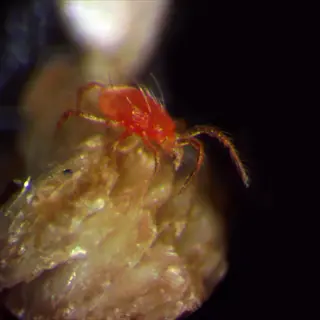
Phytoseiulus persimilis
- Feeding capacity: Consumes 5 adult spider mites or 20 eggs daily - ideal for rapid greenhouse infestations
- Release method: Distribute sachets containing eggs/larvae at 500 units per hectare for potatoes
- Optimal conditions: Thrives at 68-77°F (20-25°C) with >60% humidity; dies below 60°F (15°C)
- Habitat support: Plant pollen-rich flowers like cosmos to sustain populations between mite outbreaks
- Application tip: Introduce preventively before visible infestation - recheck ratios every 3 days
- Limitation: Less effective in outdoor fields due to migration; best for enclosed spaces
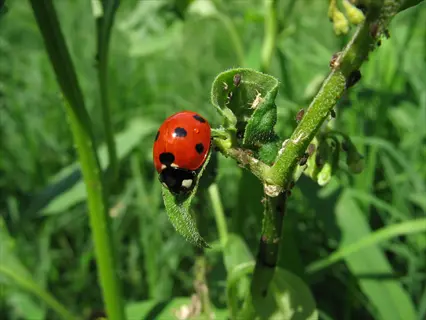
Ladybugs (Hippodamia convergens)
- Consumption rate: Adults eat 50-60 mites daily; larvae consume 30-40 mites during development
- Deployment density: Release 1,500 ladybugs per 1,000 sq ft; provide water sources for retention
- Temperature range: Most active at 65-80°F (18-27°C); hibernate below 55°F (13°C)
- Companion plants: Grow dill, yarrow, or angelica to attract and establish permanent colonies
- Monitoring: Check for orange mite eggs on leaf undersides - key early detection sign
- Caveat: May fly away if food scarce; use barrier crops like wheat to contain them
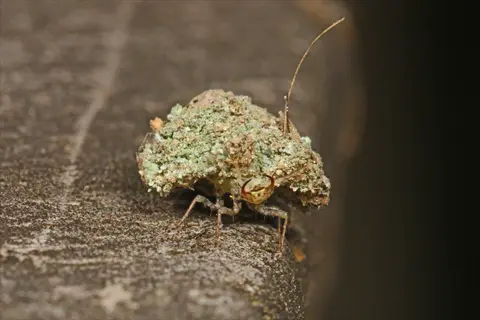
Lacewings (Chrysoperla rufilabris)
- Larval efficiency: Each larva devours 200+ mites weekly using sickle-shaped mandibles
- Release strategy: Apply 1,000 eggs per 200 sq ft weekly until infestation controlled
- Environmental needs: Prefer 70-85°F (21-29°C) with shaded, humid microclimates
- Nectar sources: Plant goldenrod or sunflower to attract egg-laying adults naturally
- Identification: Recognize alligator-like larvae with brown markings on pale bodies
- Precaution: Avoid spraying neem/oil during releases - coats wings causing suffocation
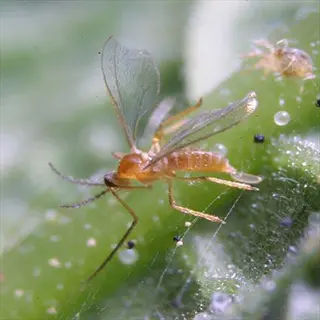
Gall Midges (Feltiella acarisuga)
- Target specificity: Larvae exclusively consume spider mites - 15 mites/hour at peak
- Introduction rate: Deploy 1 midge per 5 spider mites in high-humidity zones
- Climate preference: Optimal at 72-80°F (22-27°C); inactive below 60°F (15°C)
- Habitat enhancement: Grow fennel or dill to provide nectar for adult midges
- Lifecycle sign: Look for tiny orange larvae moving through mite webbing
- Warning: Susceptible to low humidity; maintain >65% moisture for effectiveness
Essential Tactics: Home Remedies
Precise combinations of home remedies yield safe effectiveness. Use a mixture of 30% oil and 70% water for oil sprays such as rape oil. This translates to approximately 300 ml of oil per liter of water, or approximately 10 ounces per quart. I am always cautious when measuring these substances to avoid injuring plants. The wrong concentrations of such chemicals will burn the leaves.
Treatments should be applied at the proper time. Use oil or alcohol as a remedy and apply only in the early evening. Sunlight acting on the oils causes the foliage to burn. I killed my basil plant by spraying it at noon one day. Now I wait until sundown when the temperature begins to cool off. This is to protect the delicate foliage.
Be thorough in covering all parts of the leaf surface. The spider mites hide on the underside of leaves. Use spray bottles with angled nozzles and spray thoroughly the undersides. A flashlight beam is a good way to check areas covered. Areas not sprayed become breeding places for the mites. Reapplications should be made at least every three days if oils are being used.
Adhere to prescribed limits for oil frequency. A plant is smothered if too many applications. Three applications a week, maximum, is best. My rosemary survived severe infestations on this schedule. Alcohol sped up recovery time, but had to be worked with more gently. Always spot test new applications first.
Oil-Based Sprays
- Rapeseed oil: Mix 30% cold-pressed oil with 70% water - emulsify before spraying
- Application: Coat leaf undersides at dusk to avoid sun damage; limit to 3 treatments/week
- Effectiveness: Suffocates adult mites within 24 hours but won't kill eggs
- Plant safety: Test on 2-3 leaves first; avoid on ferns or delicate herbs
- Storage: Use within 48 hours; shake vigorously before each use
- Cost: $0.50 per application for standard houseplant
Alcohol Solutions
- Isopropyl formula: 250ml (8.5 oz) 70% alcohol per liter (34 oz) water
- Application: Dab with cotton swabs on visible mites; spray lightly on larger infestations
- Effectiveness: Kills 95% mites/eggs on contact; evaporates in 15 minutes
- Safety: Use gloves/ventilation; never apply in direct sunlight
- Frequency: Apply every 2 days max for sensitive plants
- Alternative: Vodka (80 proof) works as emergency substitute
Critical Prevention Protocols
Quarantine new plants for at least two weeks before introducing them to your garden. Examine each leaf in bright light and inspect it with a 10x magnifier. I neglected this once and lost six tomato plants. See if they have stippling or fine webbing, especially on the underside of the leaves.
To better control for mites, maintain rigid environmental conditions. Maintain humidity above 60 percent and temperatures below 75°F (24°C). I use digital hygrometers in my greenhouse for accuracy. If the humidity falls below 50 percent, populations of mites will increase rapidly within days. Group plants together in a way that allows them to form microclimates with higher moisture and lower temperatures.
After each use, all tools should be sterilized. Dip pruning shears in a 70% alcohol or a 10% bleach solution for 30 seconds. I have a disinfectant jar by my potting bench. Dirty tools spread the mites faster than a gale. This simple habit saved my rose collection last season.
Limit nitrogen fertilizers to a maximum NPK ratio of 5-5-5. High nitrogen fertilizers produce soft growth that attracts mites. Its effects showed when my zucchini plants were treated with 10-5-5 fertilizer. Now, on the once-a-month soil test cycle, I select slow-release organic materials.
Plant Introduction Protocol
- Quarantine: Isolate new plants 14 days in separate room before integration
- Inspection: Examine leaf undersides with 10x magnifier; check for stippling/webbing
- Treatment: Pre-treat with neem oil dip if coming from high-risk sources
- Documentation: Log plant origin and inspection date for traceability
- High-risk plants: Avoid accepting tomatoes, cucumbers, or roses without certification
- Space requirement: Minimum 10 ft (3m) separation from existing plants
Environmental Controls
- Humidity management: Use humidifiers for indoor plants; maintain 60-80% levels
- Temperature regulation: Keep below 75°F (24°C) with exhaust fans in greenhouses
- Dust suppression: Mist pathways weekly; apply gravel mulch in outdoor gardens
- Air circulation: Install oscillating fans 3 ft (0.9m) from plants for airflow
- Watering system: Use drip irrigation to avoid foliage wetness that attracts mites
- Microclimate creation: Group plants to share humidity via transpiration
Damage Identification and Response
Recognizing spider mite injury initially is important. It begins with pale stippling on the leaves resembling the tiny needle pricks of the pest. This is followed by bronze discoloration as the cells die. Then, the fine spinning of silken webbing between the stems will be noticed. Finally, unless preventive measures are taken, severe defoliation is the result. This begins with the first signs of stippling as noted.
Isolate sick plants at once with a minimum separation of about ten feet (3 m). I keep sick plants in separate rooms. This prevents migration of mites to healthy neighbors. If plants are outdoors, isolate spaces with fine mesh material. Be certain to check daily to see how the symptoms are progressing.
Prune selectively, when damage exceeds 50% leaf cover. Use sterilized shears, which are dipped in alcohol after each cut. I destroy infected foliage in sealed bags, never compost. Green tissue is preserved for recovery. This pruning threshold is a careful balance between maintaining plant health and obtaining mite control.
Blast mites off with targeted water treatments....Using hose nozzles set to spray water at about 40 PSI (2.8 bar) pressure. Spray the undersides of leaves daily for a minimum of seven days. I do this early in the AM so that plants usually dry out by noon. Consistent high-pressure water treatment will effectively disrupt the life cycles of mites.
Early Stage Identification
- Visual signs: White/yellow stippling on upper leaf surfaces - visible under bright light
- Confirmation method: Spray water mist to reveal fine silk strands between leaves
- Magnification check: Use 10x lens to spot mites (red/yellow dots) on leaf undersides
- Affected plants: Tomatoes, beans, roses show symptoms first in dry conditions
- Response: Isolate plant immediately; begin daily water spraying on leaf undersides
- Monitoring: Check adjacent plants every 2 days for 2 weeks
Advanced Damage Response
- Severe symptoms: Bronze leaves, dense webbing on stems/fruit, leaf drop >30%
- Pruning protocol: Remove >50% damaged leaves with sterilized shears; disinfect tools after
- Water treatment: Use hose nozzle at 40 PSI (2.8 bar) pressure daily for 7 days
- Biological intervention: Release Phytoseiulus persimilis at 1:5 predator-prey ratio
- Chemical backup: Apply neem oil (2 tbsp/gal) if no improvement after 72 hours
- Quarantine: Maintain isolation for 21 days post-treatment
5 Common Myths
Vinegar sprays are claimed to kill spider mites safely without damaging plants.
Vinegar's acetic acid concentration rarely exceeds 5%, which is insufficient to penetrate mite exoskeletons while damaging plant cuticles. This weak acidity causes leaf burn on most species without eliminating eggs, potentially worsening infestations by destroying natural protective barriers.
Dish soap solutions are safe, natural alternatives to commercial miticides.
Most dish soaps contain grease-cutting agents and synthetic surfactants that remove protective wax coatings from leaves, resulting in increased dehydration stress to the plant. Dish soaps are not insec ticidal soaps designed specifically for use on plants. Dish soaps have no pH buffers, and their residues are toxic and create soil pollution, resulting in injurious effects on beneficial microbes.
Chemical pesticides are the quickest and most effective means of controlling spider mites.
Synthetic pyrethroids and carbamates will develop resistance in 2-3 generations, and will also eliminate the natural predacious insect enemies, which keep mites in check. Secondary outbreaks of spider mites will within weeks develop, as the surviving spider mites breed in thousands of numbers without enemies be, creating dependencies.
Only feeble or unhealthy plants become infested with spider mites.
Spider mites usually seek out the more succulent portions of plants, such as the young shoots of the tomato and the leaves of beans, where the plant juices are prepared in greatest supply, regardless of the general conditions of health of the plant, especially when hot and dry weather prevails.
Highly infested plants should be discarded immediately for the protection of the others.
More than 90 per cent of the plants infested with mites, will become completely recuperated, if isolated in less than 72 hours from the time of detection, and treated by means of "water blasting" and biological controls. Premature disposition results in a waste of the plants, since most of the species are able to recuperate lost foliage in less than three weeks, if the roots are kept healthy.
Conclusion
Weekly inspections of the foliage give your first line of defense against spider mites. Be sure to check your plants, especially in hot, dry weather. The sooner you detect them, the greater your chance of eradicating them before they spread. I have established a habit of checking mine every Sunday morning and having my coffee at the same time. This habit has saved my orchids three times last year.
Strictly adhere to the control hierarchy. First, seek preventive measures like quarantine and humidity control. Then, if mites show up, introduce biological predators. Only then should you attempt home remedies, such as oil sprays. Chemical approaches should be considered last. It is this very order that preserves your garden ecosystem.
Understand environmental management completely as your basis. Humidity above 60% and temperature below 75°F (24°C) are unfavorable conditions for mites. I group plants to increase the humidity naturally they share. It's a lot better to monitor them regularly than to treat them only in emergencies. Your plants thrive when you maintain a consistent environment for them.
Consistency in utilizing these techniques produces lasting protection. Sustainable spider mite control comes from daily diligence, not miracle cures. My garden now flourishes without chemicals, thanks to three years of practice. Your personal devotion creates healthy, resilient plants that naturally repel pests.
External Sources
Frequently Asked Questions
What is the most effective biological control for spider mites?
The best biological control involves releasing predatory mites like Phytoseiulus persimilis. These predators consume spider mites at all life stages. Introduce them early in infestations at specific predator-prey ratios for optimal results without chemical residues.
How often should I apply treatments to eliminate spider mites?
Treatment frequency depends on severity: early-stage infestations require daily interventions like water spraying, while advanced cases need weekly applications. Consistency is critical, interrupting treatments allows rapid population rebounds due to their reproduction cycle.
Can vinegar eliminate spider mite infestations?
Vinegar is ineffective against spider mites and harms plants. Its weak acidity damages leaf cuticles without penetrating mite exoskeletons. Instead, use targeted methods like:
- Neem oil sprays at proper dilutions
- Biological predators
- Alcohol-water solutions for direct contact kills
What immediate actions save plants with severe spider mite damage?
Isolate the plant immediately. Prune extensively damaged foliage, apply high-pressure water sprays to dislodge mites, and introduce predatory insects. Combine with neem oil applications every three days until new growth appears.
Is dish soap safe for spider mite control on edible plants?
Most dish soaps contain degreasers that strip protective waxes from leaves, causing dehydration. Use only plant-specific insecticidal soaps. For edibles:
- Opt for food-grade diatomaceous earth
- Apply diluted neem oil at dusk
- Use alcohol swabs for spot treatment
How long can spider mites survive without plants?
Spider mites perish within days without host plants. They cannot feed on non-plant surfaces but may enter dormancy. Thoroughly clean grow areas after infestations to eliminate hidden eggs in crevices or soil.
What natural methods instantly kill spider mites?
Direct sprays of diluted isopropyl alcohol provide immediate contact kills. High-pressure water blasts physically remove mites. Essential oils like rosemary or peppermint offer quick knockdown but require reapplication.
Can I reuse soil from spider mite-infested plants?
Sterilize soil before reuse to prevent reinfestation. Bake it or treat with steam to kill eggs. Avoid direct reuse, spider mite eggs persist in soil for weeks.
What humidity level prevents spider mite outbreaks?
Maintain humidity above 60% using humidifiers or pebble trays. Spider mites thrive in dry conditions, consistent high humidity disrupts their life cycle and supports predatory mites.
How do I inspect plants for early spider mite detection?
Examine leaf undersides weekly with magnification. Look for stippling, webbing, or moving dots. Quarantine new plants and monitor them closely before introducing them to your collection.

